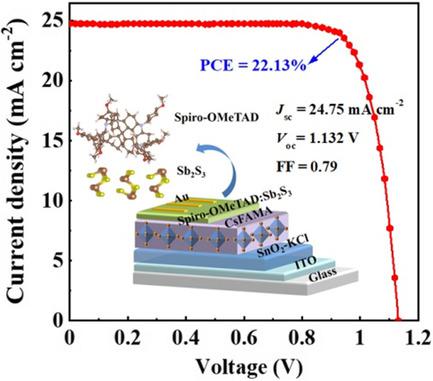Our official English website, www.x-mol.net, welcomes your
feedback! (Note: you will need to create a separate account there.)
Spiro-OMeTAD:Sb2S3 Hole Transport Layer with Triple Functions of Overcoming Lithium Salt Aggregation, Long-Term High Conductivity, and Defect Passivation for Perovskite Solar Cells
Solar RRL ( IF 6.0 ) Pub Date : 2021-09-08 , DOI: 10.1002/solr.202100622 Qing Du 1 , Zhitao Shen 1 , Chong Chen 1 , Fumin Li 1 , Mengqi Jin 1 , Huilin Li 1 , Chao Dong 2 , Jihong Zheng 1 , Mingxing Ji 1 , Mingtai Wang 2
Solar RRL ( IF 6.0 ) Pub Date : 2021-09-08 , DOI: 10.1002/solr.202100622 Qing Du 1 , Zhitao Shen 1 , Chong Chen 1 , Fumin Li 1 , Mengqi Jin 1 , Huilin Li 1 , Chao Dong 2 , Jihong Zheng 1 , Mingxing Ji 1 , Mingtai Wang 2
Affiliation

|
The development of a hole transport layer (HTL) with persistent high conductivity, good moisture/oxygen barrier ability, and suitable passivation ability of perovskite defects is very important for achieving high power conversion efficiency (PCE) and long-term stability of perovskite solar cells (PSCs). However, the state-of-the art HTL, lithium bis(trifluoromethanesulfonyl)-imide (Li-TFSI)-doped 2,2′,7,7′-tetrakis-(N,N-di-p-methoxyphenylamine)-9,9′-spirobifluorene (spiro-OMeTAD), does not have these abilities. Herein, the incorporation of antimony sulfide (Sb2S3) nanoparticles as a multifunctional additive into spiro-OMeTAD is demonstrated. The Sb2S3 effectively improve the compactness of composite spiro-OMeTAD:Sb2S3 HTL by inhibiting the Li-TFSI aggregation and effectively prevent the infiltration of moisture and oxygen into the perovskite layer, resulting in its high chemical stability. More importantly, Sb2S3 not only improves the conductivity and hole mobility of the spiro-OMeTAD:Sb2S3 through the oxidation of spiro-OMeTAD by Sb2S3, but also makes the high conductivity more durable and stable in the atmospheric environment. In addition, Sb2S3 also effectively passivates the perovskite defects and accelerates the charge transfer from perovskite layer to HTL. As a consequence, the optimized PSCs based on spiro-OMeTAD:Sb2S3 HTL exhibit a much higher PCE (22.13%) than that (19.29%) of the PSCs without Sb2S3 and show a greatly improved stability.
中文翻译:

Spiro-OMeTAD:Sb2S3 空穴传输层具有克服锂盐聚集、长期高导电性和钙钛矿太阳能电池缺陷钝化的三重功能
开发具有持久高电导率、良好的水分/氧气阻隔能力和适当钝化钙钛矿缺陷的空穴传输层(HTL)对于实现钙钛矿太阳能电池的高功率转换效率(PCE)和长期稳定性非常重要(PSC)。然而,最先进的 HTL,双(三氟甲磺酰基)-酰亚胺锂(Li-TFSI)掺杂的 2,2',7,7'-四-(N,N-二-对甲氧基苯胺)-9 ,9'-螺二芴(spiro-OMeTAD)不具备这些能力。在此,证明了将硫化锑 (Sb 2 S 3 ) 纳米颗粒作为多功能添加剂掺入螺-OMeTAD 中。Sb 2 S 3通过抑制Li-TFSI聚集,有效提高复合spiro-OMeTAD:Sb 2 S 3 HTL的致密性,有效防止水分和氧气渗入钙钛矿层,使其具有较高的化学稳定性。更重要的是,锑2小号3的Sb:不仅提高了螺环-OMeTAD的导电性和空穴迁移率2小号3通过螺环-OMeTAD,以Sb氧化2小号3,也使得高导电性的更耐用和稳定的大气环境。此外,Sb 2 S 3也有效地钝化钙钛矿缺陷并加速电荷从钙钛矿层转移到 HTL。因此,基于spiro-OMeTAD:Sb 2 S 3 HTL的优化PSCs表现出比没有Sb 2 S 3的PSCs (19.29%) 高得多的PCE (22.13%)并显示出大大提高的稳定性。
更新日期:2021-11-04
中文翻译:

Spiro-OMeTAD:Sb2S3 空穴传输层具有克服锂盐聚集、长期高导电性和钙钛矿太阳能电池缺陷钝化的三重功能
开发具有持久高电导率、良好的水分/氧气阻隔能力和适当钝化钙钛矿缺陷的空穴传输层(HTL)对于实现钙钛矿太阳能电池的高功率转换效率(PCE)和长期稳定性非常重要(PSC)。然而,最先进的 HTL,双(三氟甲磺酰基)-酰亚胺锂(Li-TFSI)掺杂的 2,2',7,7'-四-(N,N-二-对甲氧基苯胺)-9 ,9'-螺二芴(spiro-OMeTAD)不具备这些能力。在此,证明了将硫化锑 (Sb 2 S 3 ) 纳米颗粒作为多功能添加剂掺入螺-OMeTAD 中。Sb 2 S 3通过抑制Li-TFSI聚集,有效提高复合spiro-OMeTAD:Sb 2 S 3 HTL的致密性,有效防止水分和氧气渗入钙钛矿层,使其具有较高的化学稳定性。更重要的是,锑2小号3的Sb:不仅提高了螺环-OMeTAD的导电性和空穴迁移率2小号3通过螺环-OMeTAD,以Sb氧化2小号3,也使得高导电性的更耐用和稳定的大气环境。此外,Sb 2 S 3也有效地钝化钙钛矿缺陷并加速电荷从钙钛矿层转移到 HTL。因此,基于spiro-OMeTAD:Sb 2 S 3 HTL的优化PSCs表现出比没有Sb 2 S 3的PSCs (19.29%) 高得多的PCE (22.13%)并显示出大大提高的稳定性。











































 京公网安备 11010802027423号
京公网安备 11010802027423号